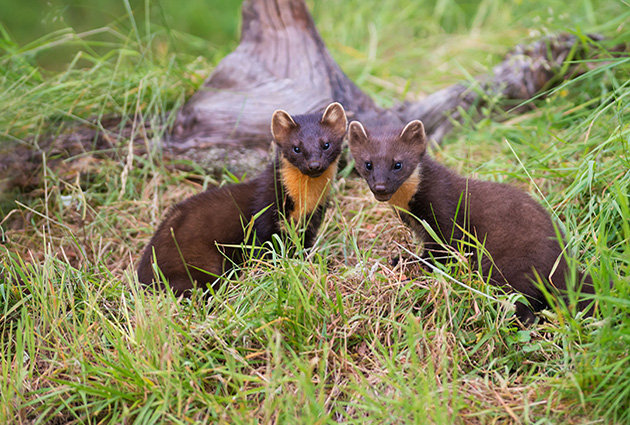The pine marten stages a comeback
Could the return of the pine martin help to preserve the red squirrel?


Once common throughout the United Kingdom - how often this phrase recurs when writing about our wildlife - the pine marten is now a denizen of remote, mostly forested places. Historically, it had the misfortune of being both pursued as vermin and possessing a desirable pelt. It remains a glamorous fugitive; even the droppings are said to smell rather like Parma violets.
Martes martes is a lithe and spectacular mustelid that occurs across Europe and parts of Asia, but is the only species in the British Isles (the similar beech marten was once thought to co-exist here). A mature male can weigh 3lb and sports a foot-long tail. Its winter coat is especially lustrous a rich, brown fur as dark as builders’ tea before milk and a reddish-grey under fur tipped with yellow. There is a distinctive, creamy bib (occasionally tinged with orange) and the marten’s triangular head has cute, rather prominent ears. The semi-retractable claws and bushy tail assist in its impressive arboreal athleticism. It is truly a creature of rare grace.

Crepuscular and nomadic, it ranges widely by night, but is rarely seen in daylight. Traditionally a beast of old Scottish pine forests, the taghan (as it is called in the Gaelic) is particular about habitat, favouring trees with rough bark for traction and a canopy over its head. It has been forced to adapt to crags, cairns and moorland, but, being vulnerable to foxes, tends to avoid open spaces. An agile climber, it proceeds across terra firma with that trademark ‘caterpillar bound’ of the mustelidae ‘hind parts shouldered up’, in the words of John Clare and can execute prodigious leaps, especially in the snow.
An enthusiastic omnivore, the marten requires up to 20% of its bodyweight in food daily and makes a living seasonally from field voles, rabbits, fungi, berries and small birds. In winter, it will resort to carrion deer or sheep although Osgood Mackenzie, in 1875, discovered a marten that had been crushed to death by a Cheviot wedder, its teeth still locked around her throat. It enjoys a notorious reputation among poultry keepers for mass slaughter and, in some places, displays a penchant for black game and red squirrels—although the latter are often light enough to escape to safety at the extremity of slender branches.
The taghan marks its extensive territory with musky urine, frequently rubbing its glands across objects along the home range. Depending on diet, its dark faeces or ‘scats’ have a tubular, twisted appearance; I have only ever seen one marten near our Perthshire home, but any suspected droppings have so far failed the violet-aroma test.
Maintaining several lairs and dens in abandoned dreys and birds’ nests, the marten breeds in high summer. The female, usually silent, is said to make a ‘clucking’ sound once oestrus begins and she may entertain several mates during her season. Copulation can occur in trees; observers report much growling during the hour-long act and the ‘dog’, equipped with a formidable baculum, or penis bone, frequently seizes his lady-love by the scruff of her neck. Delayed implantation of the fertilised eggs typically results in a litter born in early April two to five blind offspring that are covered in yellowish hair and are taught survival skills by the mother. When in difficulties, the kits utter a sound like paper being torn.
Classified in medieval times as one of the ‘beasts five of the chase’, the marten or ‘matron’ was popular as ‘the sweetest vermine that is hunted’, since its scent was so attractive to hounds unlike the disagreeable reek of the polecat, or ‘foul mart’. Its fur was classified as semi-precious (the collective noun is a ‘richness’ of martens) and archaeological remains suggest it has been pursued since Mesolithic times, probably for food as well as clothing.
Exquisite houses, the beauty of Nature, and how to get the most from your life, straight to your inbox.
But even by the Tudor period, when parish records show bounties being offered, the pine marten seems to have been on the wane and, by the First World War, there were just a few relict populations in Snowdonia, Cumberland and the Highlands. The last marten in the London region was shot in Epping Forest in 1883.
Fully protected since 1988, the marten seems to be staging a comeback. Scottish numbers are estimated at some 3,500 and their range now includes Galloway, Deeside, Argyll and the Grampians. Replanting of forestry has helped and, elsewhere, a successful translocation to Wales (thanks to the Vincent Wildlife Trust) and a recent sighting in Shropshire.
Despite a feather versus fur controversy involving those who believe it predates on endangered capercaillie, reintroduction of the marten appears to benefit the red squirrel (despite the evidence of the photograph above); interloper greycoats retreat from their territory as martens advance, so it may be this offers a partial, but natural solution to one of the greatest scourges of our British countryside.
Country Life is unlike any other magazine: the only glossy weekly on the newsstand and the only magazine that has been guest-edited by His Majesty The King not once, but twice. It is a celebration of modern rural life and all its diverse joys and pleasures — that was first published in Queen Victoria's Diamond Jubilee year. Our eclectic mixture of witty and informative content — from the most up-to-date property news and commentary and a coveted glimpse inside some of the UK's best houses and gardens, to gardening, the arts and interior design, written by experts in their field — still cannot be found in print or online, anywhere else.
